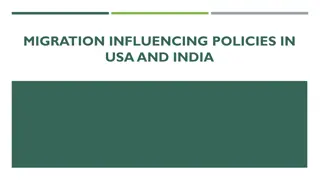Population Policies in India: Evolution and Impact
Population policies in India have evolved over the years, focusing on areas such as contraception, health care infrastructure, and integrated service delivery. The policies under different Five-Year Plans have emphasized various approaches, including natural family planning, sterilization techniques, and setting minimum marriage ages. The National Population Policy of 2000 was a significant milestone in addressing India's growing population concerns, aiming for sustainable growth and development.
Download Presentation

Please find below an Image/Link to download the presentation.
The content on the website is provided AS IS for your information and personal use only. It may not be sold, licensed, or shared on other websites without obtaining consent from the author. Download presentation by click this link. If you encounter any issues during the download, it is possible that the publisher has removed the file from their server.
E N D
Presentation Transcript
COURSE: B.Sc. (PROGRAMME) IN ECONOMICS PAPER NAME BASIC FEATURES OF INDIAN ECONOMY TOPIC POPULATION POLICIES IN INDIA YEAR- SECOND SEMESTER-3 SESSION -2021-2022 DATE OF LECTURE: 16/09/2021 PREPARED BY DR. KAMALIKA CHAKRABORTY ASSISTANT PROFESSOR (DEPARTMENT OF ECONOMICS) KHATRA ADIBASI MAHAVIDYALAYA, BANKURA, WEST BENGAL
What are Population Policies? Population policies are being developed to address unmet needs in relation to population. It includes contraception, health care infrastructure, and health personnel, as well as providing integrated service delivery for basic reproductive and child health care. The primary goal of population policies is to achieve a stable population that meets the requirements of long-term economic growth, social development, and environmental protection. The Government of India has developed several policies for population control in various Five- Year Plans.
Population Policies Under Five Year Plans First Five Year Plan: In 1952, India became the first country in the world to implement a population control programme. It emphasised the use of natural family planning devices. Second Five-Year Plan: Work was done in the areas of education and research, with a focus on the clinical approach. Third Five Year Plan: The sterilisation technique for both men and women was adopted under the Third Five- Year Plan in 1965. The copper- T technique was also used. The Family Planning Department was established as a separate entity. Fourth Five-Year Plan: All forms of birth control were encouraged (both traditional and modern). Fifth Five Year Plan: The National Population Policy was announced on April 16, 1976, as part of the fifth five- year plan.
The Sharda Act of 1929 set a minimum age for marriage, which was raised under this policy. It raised the minimum age for boys to 21 years old and for girls to 14 years old. On the basis of the 1971 census, the number of MPs and MLAs was fixed until 2001. Forced sterilisation was permitted under this plan, but it was later abolished. The name of the Family Planning Department was changed to Family Welfare Department by the Janata Party government in 1977. Sixth to Eighth Five Year Plan: Efforts were made to control population in the Sixth, Seventh, and Eighth Plans by determining long-term demographic goals. Ninth Five-Year Plan: In 1993, the government established an expert group to formulate national population policy under the chairmanship of M.S. Swaminathan. Despite the fact that this group drafted a new population policy in 1994, it was reviewed by the Family Welfare Department in 1999 and passed by Parliament in 2000. In February 2000, the central government released the "new national population policy."
National Population Policy, 2000 On May 11, 2000, India's population surpassed 100 crore, and it was predicted that if current population growth trends continued, India will overtake China as the world's most populous country by 2045. During the twentieth century, India's population increased nearly fivefold, from 23 million to 100 million, while the world's population increased nearly threefold, from 200 million to 600 million. With a current annual population increase of 1.55 crore, it appears that maintaining a balance to conserve the country's resource endowment and environment will be difficult. Population stabilisation is critical for promoting sustainable development with more equitable distribution. The National Population Policy, which was announced on February 15, 2000, provided a policy framework for advancing goals and priorities to various strategies in order to meet India's reproductive and child health needs and achieve TFR by 2010. The policy's main goal was to address a variety of issues related to maternal health, child survival, and contraception, as well as to make reproductive health care more accessible and affordable to everyone.
Objectives Temporary objective: The provision of birth control devices was included as a temporary goal. It also included the development of a health-protection framework and the recruitment of health-care workers. Mid-term objective: By 2010, the total fertility rate (TFR) had to be reduced to 2.1, which was the replacement level. Long-term objective: The goal is to achieve population stabilisation by 2045. The population must be stabilised at a level that is harmonious in terms of economic, social, and environmental development and protection. Targets By 2045, achieve a population growth rate of 0 percent. Lower the infant mortality rate to less than 30 per 1,000 live births. Lower the maternal mortality rate to less than 100 per 1,000 live births. By 2010, the birth rate should be reduced to 21 per 1000. By 2010, reduce the total fertility rate (TFR) to 2.1.























